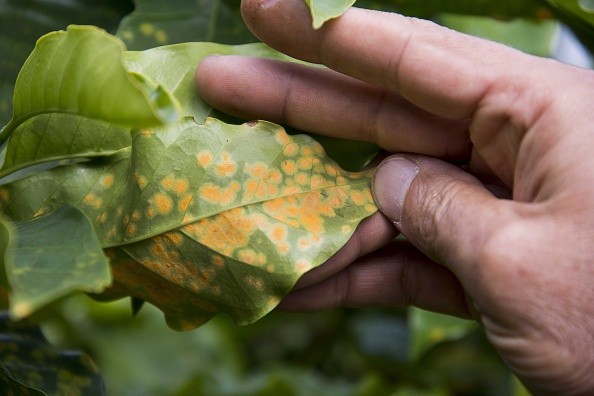There have been urgent requests for a national response after an invasive fungus that is harming some of Australia's most ecologically significant tree species spread to Western Australia and flourished in the moist conditions along the country's east, causing a silent extinction.
The production of tea tree oil, forestry, nursery and garden products, as well as ecosystems, are all at risk from the fungal disease known as myrtle rust.
Numerous Myrtaceae plants, including gum trees, lily pillies, tea trees, bottlebrushes, and native guavas, are affected.
Myrtle Rust
 (Photo : EZEQUIEL BECERRA/AFP via Getty Images)
(Photo : EZEQUIEL BECERRA/AFP via Getty Images)

As of 2010, there has been myrtle rust in Australia, and there are currently 400 species inside its known host range.
Ecosystems, such as some World Heritage sites, have experienced effects in coastal heath, littoral, subtropical and tropical rainforest, wet and dry sclerophyll, and sand island ecosystems, as per Queensland Government.
While the information on the effects has been recorded for several Myrtaceae species, the wider ecological effects of the loss of such species are still being felt.
Since myrtle rust generates thousands of spores that are easily dispersed by wind, human activity, and animals, it cannot be completely eradicated.
Nowadays, the study is concentrated on comprehending the effects on specific plant species as well as their communities to support the development of long-term and effective management strategies.
To offer a collective approach to myrtle rust research and on-the-ground actions in Australia, a Myrtle Rust National Action Plan has been created.
Its objectives are to reduce native species declines and extinctions brought on by myrtle rust, as well as to mitigate the deterioration of the host ecosystems' integrity and functionality.
Also Read: Deadly Fungus That Pierces Ants' Gut Cells are Wiping Out Invasive Ant Colonies in the U.S.
Spreading of Myrtle rust in WA's Kimberly
The risks could be hugely damaging for those ecosystems if the myrtle rust fungus discovered in the east Kimberley spreads to the state's biodiversity-rich south-west, experts warn, as per The Guardian.
According to a study published in 2021, the myrtle rust could cause the extinction of at least 16 rainforest plants together within a generation, an unprecedented scale of extinction.
In the east Kimberley in late June, a team led by WA's Department of Primary Industries discovered the fungus on nine broad- and narrow-leafed paperbark trees.
It is unknown which particular melaleuca species is affected.
The department is inspecting nurseries and tourist hotspots, but there have been no recent discoveries.
A department spokesperson said that while the exact effects were still unknown, the disease may harm ecosystems by causing species extinction, dieback, and tree death.
After modeling suggested a secluded wetland as a likely location, spreading from affected plants in the Northern Territory to the east, the area was searched.
Alyssa Martino, a research scientist at the University of Sydney, has started examining the vulnerability of 25 varieties of melaleuca trees in Western Australia to the South American fungus.
The initial three tests have demonstrated greater vulnerability.
Because the fungus thrives in new growth following rain or after a bushfire and prefers humidity and moist conditions, the country's eastern wet regions had created the ideal environment.
The national action plan has been completed in 2020, but governments have not yet officially adopted it.
Tanya Plibersek, the federal environment minister, concurred that a coordinated response has been required and stated that the government was working to put a national action plan into effect.
According to her, targeted investments have been allocated to conduct a national inventory of species that are susceptible to myrtle rust and to provide Indigenous rangers and landowners in NSW and Queensland with specialized myrtle rust training.
Related Article: Deadly Fungus Killing Thousands of Trees in Everglades
© 2024 NatureWorldNews.com All rights reserved. Do not reproduce without permission.




![Roundworms with Short Memories 'Stop Forgetting' When Frozen or Given Lithium [Study]](https://1471793142.rsc.cdn77.org/data/thumbs/full/70295/280/157/50/40/roundworms-with-short-memories-stop-forgetting-when-frozen-or-given-lithium-study.jpg)
